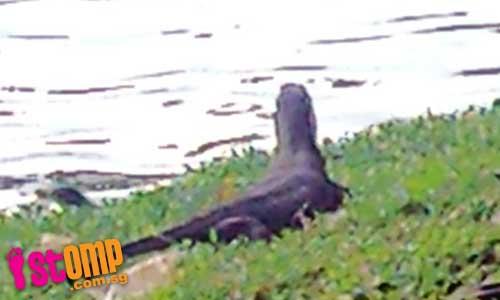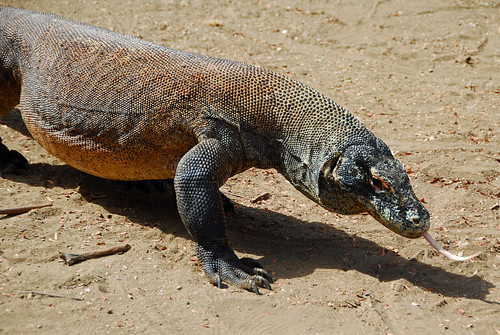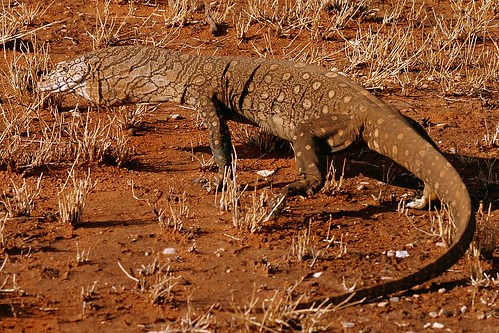
STOMPer Philip was shocked when he saw this approximately one-metre-long cold blooded creature at Jurong Lake, and wonders if this is a Komodo Dragon.
Says this STOMPer:
"I was shocked to see this 'Komodo Dragon' this this morning, July 21 while I was doing my morning exercise at Jurong Lake.
"Looks like a Komodo Dragon, but I think it's probably not?
"It was about one metre in length."
As usual, I see a case of people being ignorant about our local wildlife. It's not as if the Malayan water monitor (Varanus salvator) is rare or endangered; these giant reptiles are quite widespread and common, and can be found living close to human activity.

Malayan water monitor, Sungei Buloh Wetland Reserve;
(Photo by yeowatzup)
The Malayan water monitor is one of the world's largest lizards, after the infamous Komodo dragon (Varanus komodoensis). An individual caught in Sri Lanka in the 1940s is apparently the longest verified record at 321 centimetres; this would make it even longer than the largest Komodo dragon (which measured 313 centimetres)! However, most individuals don't reach such monstrous proportions, with most of them maxing out at 2.5 metres, which is still a very impressive size.

Komodo dragon, Rinca;
(Photo by Jano "Square")
It is unfortunate that people have a habit of mistaking the Malayan water monitor for the Komodo dragon. The latter is restricted to a scattering of small islands east of Bali in Indonesia. The main islands where these giant lizards are found are Rinca, Flores and of course, Komodo. Malayan water monitors do live alongside Komodo dragons on these islands, but so far, it appears that there are no records of interactions between the 2 species.
Besides the Komodo dragon and Malayan water monitor, there are a couple of other giant monitor lizards that are worthy of mention here.

Perentie (Varanus giganteus), Exmouth;
(Photo by wayne_brbr)
The perentie is the largest monitor lizard native to Australia, reaching up to 2.5 metres in length, although such giants are the exception rather than the rule. Found in semi-arid and arid areas of central and southern Australia, this giant is relatively slender, and less hefty than a Komodo dragon or Malayan water monitor.

Crocodile monitor (Varanus salvadorii), Central Florida Zoo;
(Photo by herpimage)
The size of the crocodile monitor of New Guinea is a controversial topic; many reports claim that it can grow up to 4.5 metres in length, and this is repeated in many older books. However, the largest verified record is "only" 2.4 metres. This is the most arboreal of the giant monitors, and is sometimes known as the tree crocodile.
The Malayan water monitor is the species most commonly encountered by Singaporeans, especially in coastal areas and around reservoirs. However, this is not the only species of monitor lizard to occur in Singapore.

Clouded monitor (Varanus bengalensis nebulosus), Hindhede Nature Park;
(Photo by NatureInYourBackyard)
The clouded monitor is quite frequently spotted in our Central Nature Reserves, either basking in the sun, or foraging for food. It is smaller than the Malayan water monitor, with rare records of individuals growing to 1.5 metres in length.

Dumeril's monitor (Varanus dumerilii);
(Photo from Roughneckmonitors.com)
Dumeril's monitor was recently rediscovered in the Nee Soon Swamp Forest. This species, which averages between 1 and 1.5 metres in length, is highly prized in the exotic pet trade, due to the extremely attractive coloration seen in young specimens:

Hatchling Dumeril's monitor;
(Photo by Herpetologe)
In a very interesting piece of recent news regarding monitor lizards, the discovery of a new species of monitor lizard has just been announced.

Lirung monitor (Varanus lirungensis);
(Photo by André Koch)
The Lirung monitor is restricted to the Talaud Archipelago, which are situated between the Indonesian island of Sulawesi, and Mindanao in the Philippines. Its name is derived from the village of Lirung on the island of Salibabu, the second largest island in the Talaud group, which was also where this species was first found.
It had been assumed all along that the monitor lizards of the Talaud Archipelago were Malayan water monitors, but it turned out that the Lirung monitor is not just a new species, it shares close affinities with the mangrove monitor (Varanus indicus), a species found further east, in northern Australia, New Guinea, the Solomon Islands, and many other islands in the western Pacific.

Mangrove monitor, Saipan;
(Photo by tropical.pete)
It's almost certain that there are more monitor lizard species out there waiting to be discovered; further study has revealed that monitor lizards are much more diverse than traditionally thought, and that many forms warrant separation as distinct species from their closest relatives. For example, the water monitor lizards of the Philippines were once considered to be subspecies of the Malayan water monitor, but the general consensus is that these actually constitute 3 separate species. Similarly, as more is done to study the distribution and ecology of monitor lizards in the wild, it is likely that more species will be described and named in future.